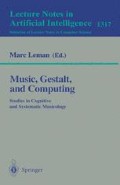Abstract
Usually, in the spoken language, a speaker can give different meanings to his words by introducing variations in the prosodic factors of the sentence. In a musical performance, the player can also introduce different expressive intentions within, naturally, the limitations of the score. Attention here, is turned towards the analysis how these intentions are communicated to the listeners. Perceptive tests were used to determine how some listeners' impressions arranged the musical pieces heard within a hypothetical n-dimensional space. Factor Analysis, MultiDimensional Scaling and Cluster Analysis applied to the subjects' replies verified that groups of listeners with different cultural preparation, could recognize the performer's intentions. It was then possible to reduce the size of the problem, in that the subjects had created a space into which the pieces were set, so that these could be subdivided into a reduced number of clusters. The synthesis of some performances and the successive perceptive analysis of the same, verified the results emerging from this study.
Preview
Unable to display preview. Download preview PDF.
References
Canazza, S., De Poli, G., Rinaldin, S., & Vidolin, A. (1997). Sonological analysis of clarinet expressivity. In M. Leman (Ed.), Music, Gestalt, and computing: Studies in cogntive and systematic musicology. Berlin, Heidelberg: Springer-Verlag.
Friberg, A., Fryden, L., Bodin, L., & Sundberg, J. (1991). Performance rules for computer-controlled contemporary keybord music. Computer Music Journal, 15,49–55.
Gabrielsson, A. (1973). Similarity ratings and dimensional analysis of auditory rhythm patterns. Scandinavian Journal of Psychology, 14, 138–160.
Gabrielsson, A. (1993). Intentional and emotional expression in music performance. In Proceedings of the Stockholm Music Acoustics Conference (pp. 108–111). Stockholm.
Gabrielsson, A. (1995). Expressive intention and performance. In R. Steinberg (Ed.), Music and mind machine (pp. 37–47). Berlin, Heidelberg: Springer-Verlag.
Nakamura, T. (1987). The communication of dynamics between musicians and listeners through musical performance. Perception and Psychophysics, 41, 525–533.
Namba, S., Kuwano, S., Hatoh, T., & Kato, M. (1991). Assessment of musical performance by using the method of continous judgment by selected description. Music Perception, 8, 251–276.
Repp, B. (1990). Patterns of expressive timing in performances of a Beethoven minuet by nineteen famous pianists. The Journal of the Acoustical Society of America, 93, 622–641.
Repp, B. (1995). Quantitative effects of global tempo on expressive timing in music performance: Some perceptual evidence. Music Perception, 13, 39–57.
Seashore, C. (1938). Psychology of music. New York, NY: McGraw-Hill.
Senju, M., & Ohgushi, K. (1987). How are the player's ideas conveyed to the audience? Music Perception, 4, 311–324.
Vercoe, B. (1993). Csound: A manual for the audio processing system and supporting programs. Cambridge, MA: The MIT Press.
Author information
Authors and Affiliations
Editor information
Rights and permissions
Copyright information
© 1997 Springer-Verlag Berlin Heidelberg
About this paper
Cite this paper
Canazza, S., De Poli, G., Vidolin, A. (1997). Perceptual analysis of the musical expressive intention in a clarinet performance. In: Leman, M. (eds) Music, Gestalt, and Computing. JIC 1996. Lecture Notes in Computer Science, vol 1317. Springer, Berlin, Heidelberg. https://doi.org/10.1007/BFb0034132
Download citation
DOI: https://doi.org/10.1007/BFb0034132
Published:
Publisher Name: Springer, Berlin, Heidelberg
Print ISBN: 978-3-540-63526-0
Online ISBN: 978-3-540-69591-2
eBook Packages: Springer Book Archive

